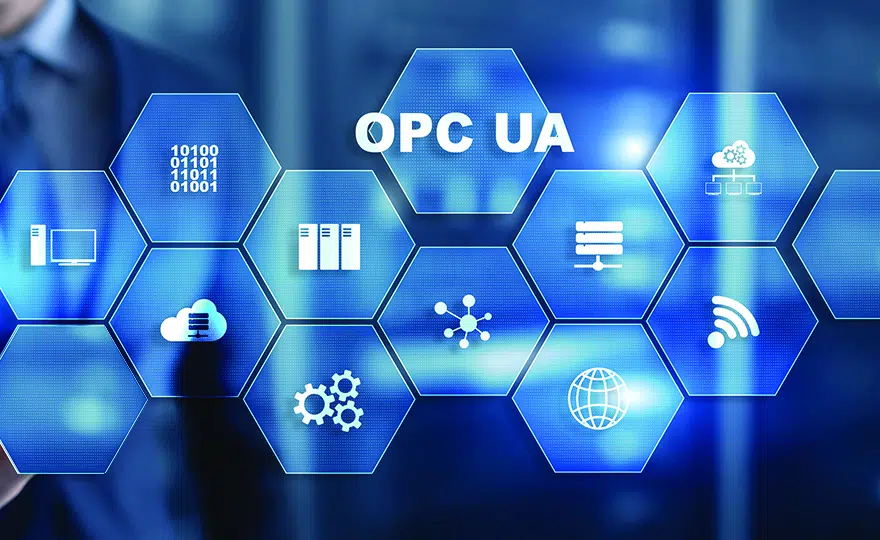
4 Reasons- Why TSN for Motion Control Applications?
Backdrop of Communication Protocols in Industries
The IT and OT layers of the automation pyramid execute two different types of real-time operations, i.e., soft real-time communications and hard real-time communications, respectively. The soft real-time communications mostly take place across the IT applications horizontally and vertically across MES, ERP, cloud, and control systems. On the other hand, hard real-time communications take place horizontally across machines, and vertically among controllers, and SCADA/HMIs.
While soft real-time operations can bear the latency of 10 to 50 milliseconds, most hard real-time operations can get severely impacted if the latency is more than 1 millisecond. Motion control applications are usually hard real-time bound and usual network errors like indeterminism, jitter, high latency, and bandwidth can severely impact the throughput.
Imagine a robotic arm that is moving items on a conveyer belt and passing to the next station for further processing, must be highly precise and accurate in terms of its timings. A delay of a fraction of seconds can damage the items or break the operation continuity.
This clearly underlines the demands of cutting-edge machines, i.e., speed, precision, and determinism. At present, Fieldbus and Ethernet are the two majorly used networking technologies on plant floors. With continuous updates in Ethernet standards, it is also becoming gradually popular for OT layer operations.
Challenges in Existing Networking
There have been several communication technologies that have emerged for field level, but Ethernet and Fieldbus protocols are most widely adopted across industries. However, despite several periodic upgrades, the industrial plant floor experiences the following challenges:
- Latency: The Generation 1 industrial networking technologies like RS 232 & RS 485, SERCOS, DeviceNet, etc., were able to support data transfer over long distances. However, the rate of data transfer was very low, i.e., approximately 1 Mbit/sec. To overcome this, Ethernet with an established physical layer became the primary choice for industries. Gradually the Generation 2 networking technologies started emerging with Ethernet PHYs such as Profibus with PROFINET, Modbus with Modbus TCP, CC-Link with CC-Link IE, etc. However, even with many standards, Ethernet is still unable to address the latency and determinism needs of the industrial networks. Although, PROFINET IRT offers the same deterministic capabilities that is expected for hard real-time operations. However, a precise timing model is necessary to plan the traffic slices. Unfortunately, the latency in standard Ethernet can be assured up to a certain extent due to its store and forward strategy.
- Jitter: One of the biggest challenges that industrial motion control applications face is certainly not the slow speed of the connectivity. It is rather the jitter. Jitter can be understood as the variance in latency. Sadly, the data transmission over TCP, IP, or UDP necessarily exhibits jitter. Due to the lack of traffic prioritizing and slicing ability, the varying latency interferes with the plant floor operations to a great extent, especially when the operations are time-critical.
- Implementation Complexities: The Generation 1 industrial networking technologies had different physical layers, which did not allow them to share common wiring across heterogeneous networks. Subsequently, the Generation 2 network solutions used common Ethernet PHY, but proprietary layer 2 implementations still cannot allow them to be transmitted over the same cable. This is a serious installation complexity for a plant floor with variants of machines and devices supporting multiple vendors. This is an ideal case of manufacturer lock-in as it forces the industrial plants to be confined with selected vendor(s).
As opposed to top layer application requirements, plant floor requires the network connectivity to have ultra-low latency, fixed jitter, and deterministic capabilities. These necessities call for a networking standard that not only allows the connectivity to be time-sensitive, but also spans across all the layers of the automation pyramid.
What is Time-Sensitive Network (TSN)?
Ethernet is one of the most preferred networking technologies for top layers of the network. However, it is gradually becoming the right choice for the factory settings also. The way to resolve the common issues present in standard and industrial Ethernet is to introduce new networking standards in the Layer II of the OSI model. These brand-new standards are combinedly termed as Time Sensitive Network, abbreviated as TSN.
TSN is an extension of Audio Video Bridging technology (a set of standards that allows high-quality streaming of audio and video signals over standard Ethernet). The IEEE 802.1 TSN Task Group developed the TSN standard, which can solve all the challenges that were present in standard and industrial Ethernet. A few of many standards in the TSN specification that can connect the automation pyramid in a single thread are:
- IEEE 802.1AS: A mechanism that synchronizes the messages and delays of all the nodes in the network by keeping them identical to the clock of the Grandmaster node, called Grandmaster Clock. The Grandmaster is selected using an algorithm called Best Master Clock Algorithm (BMCA). The BMCA is responsible for broadcasting the time and measuring the delays to maintain the schedule.
- IEEE 802.1 Qbv: A standard that schedules the traffic based on the time shared by the grandmaster node. 802.1Qbv defines a mechanism to control the flow of queued messages through the TSN switches. This ensures that only the scheduled messages are released in those time windows. The non-scheduled traffic is blocked, which thereby enables the delays from each switch to be deterministic.
- IEEE 802.1Qbu: This standard interrupts the large low-priority Ethernet frames in order to transmit high-priority traffic. Post this it resumes sending the remaining part of the large frame without impacting or losing previously transmitted data.
- Other Standards: Some of the other standards that define various features of TSN are:
| 802.1CB | Frame Replication and Elimination (FRER) adds fault-tolerance to the network |
| 802.1Qca | Explicit path control, bandwidth and stream reservation, redundancy (protection or restoration) for data flows |
| 802.1Qcc | Offline/online configuration of TSN network scheduling |
| 802.1Qci | A policing and filtering standard that mitigates the risk of incorrect node functions |
| 802.1Qch | Defines traffic for forwarding queued traffic |
| IEEE 802.1Qcr | Provides bounded latency and jitter |
Migrating to a TSN-based Ethernet network will require special hardware features like PTP protocol (Precision Time Protocol) to synchronize the network clock and PHY/MAC to modulate/demodulate and send/receive the signals. Determinism in motion control applications can be brought through specific protocols like EtherCAT, Profinet IRT, and EtherNet/IP among others.
Why TSN for Motion Control Applications?
TSN comes with the strength to revamp motion control applications. It does so by enabling the factories to cope with the long-standing issues of incompatibility among the machines, absolute real-time deterministic communication, and much more. Take a look.
- Scalability: TSN will proliferate the use of Standard Ethernet across the automation pyramid. This will allow factories to utilize the existing top layer network settings for the field layer as well. This also implies that adding new machines/devices will be easier without having to worry about the vendors and make. Therefore, one network the from field layer to the top layer.
- Interoperability: TSN eliminates the persistent issue of incompatibility among the motion control devices and applications by allowing the Commercial Off the Shelf (COTS) networking technologies to be implemented on top of the Data Link Layer of the OSI model. Not only this, with Ethernet’s backward compatibility, device engineers will be able to incorporate TSN in their networks without having to worry about obsolescence encouraging improved interoperability among old and new machines/devices.
- Greater Scope for IIoT: With the ability to classify the bandwidth for time-critical and non-critical message queues, TSN allows the same network to be used for various motion control and other applications. This also simplifies networking across OT and IT layers allowing a smoother communication model between the machines on the plant and the client applications at the IT layer. Therefore, improved scope for IIoT.
- Lower Maintenance Cost: With one standard technology across the communication hierarchy, the complexity of maintaining two separate technologies in IT and OT layers is eliminated. This further leads to lesser cables and hardware, thereby incurring lesser maintenance cost.
Footnote
The growing importance of real-time data accessibility for time-critical motion control applications has pushed the protocol associations to create their adaptation of TSN. TSN will definitely enable multiple protocols to be implemented on top to deliver cutting-edge solutions. Utthunga is renowned for having a tremendous success rate in delivering best in-class solutions. Our product engineering capabilities span across all the layers of the automation hierarchy. Our motion control services extend over hardware and firmware development, application development, obsolescence management, Value Analysis and Value Engineering, lifecycle management, validation and verification, pre-compliance and certification support, and a lot more.
Check out our motion control services here!




